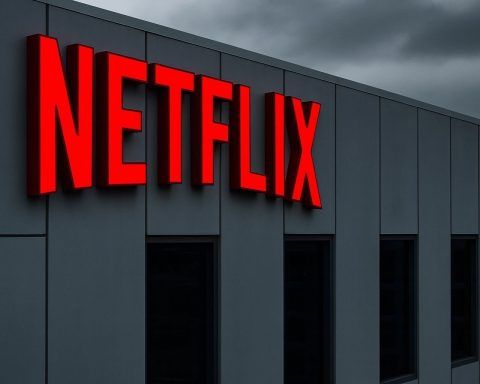- Record Highs & Pullback: The S&P 500 and Nasdaq Composite hit fresh all-time highs to start the week, then retreated on profit-taking the next day [1] [2]. The Dow Jones also swung from slight gains to modest losses.
- Tech Surge on AI News: A massive AI chip deal involving OpenAI propelled tech stocks – AMD skyrocketed ~24% on Monday and kept rising Tuesday [3] [4], lifting the Nasdaq. But by Tuesday, investors grew wary of lofty tech valuations, pausing the rally [5].
- Safe Havens Soar: Gold prices breached $4,000/oz for the first time ever amid economic jitters and a U.S. government shutdown, while Bitcoin hit a record ~$125,000 before pulling back [6] [7]. Defensive sectors like utilities and consumer staples led gains as traders sought safety [8].
- Big Bank Merger: Fifth Third Bancorp’s $11 billion deal to acquire Comerica jolted the financial sector. Comerica’s stock spiked nearly 14% on the news [9], signaling renewed M&A momentum despite political uncertainty.
- Tesla’s Twists: Tesla jumped over 5% Monday on hype around a product event, then slid ~4.5% Tuesday after unveiling lower-priced Model 3 and Model Y vehicles [10] [11]. The EV maker’s volatility swung consumer discretionary stocks from leadership to laggard.
- Fed “Flying Blind”: With the government shutdown halting key economic reports, investors parsed Fed officials’ comments for clues [12] [13]. A Fed survey showed rising inflation expectations as data went dark, and one Fed governor urged more rate cuts to prevent over-tightening [14] [15]. Markets are betting on a Fed rate cut at the end of October, adding to this year’s dovish pivot.
- Global Cross-Currents: Political turmoil abroad added to market caution. France’s prime minister resigned, spooking European markets and denting the euro [16], while a new dovish leader in Japan sent the yen to 8-month lows [17]. Meanwhile, oil crept higher on an OPEC+ output tweak and China’s weak auto demand hit European carmakers – reminders of worldwide influences on U.S. sentiment.
Market Index Roundup (Oct 7–8, 2025)
U.S. equities see-sawed over the past two days. On Tuesday (Oct 7), the major indexes pulled back modestly after a multi-session winning streak: the S&P 500 fell about 0.4%, the Dow Jones Industrial Average slipped 0.2%, and the Nasdaq Composite dropped 0.7% [18]. Notably, this retreat came immediately after the S&P and Nasdaq had touched intraday record levels earlier that day [19]. The dip snapped the S&P’s seven-day rally [20], as traders locked in profits from the market’s recent run-up.
These declines followed a banner session on Monday. In the Oct 6 session, the S&P 500 and Nasdaq closed at record highs – continuing a trend of new peaks – while the Dow ended slightly lower [21]. The tech-heavy Nasdaq climbed +0.7% and the S&P 500 +0.4% on Monday, even as the Dow inched down -0.1% [22]. This divergence reflected strong enthusiasm for growth and tech shares to start the week, whereas some blue-chip stocks lagged. By Wednesday morning (Oct 8), U.S. stock futures were relatively flat, suggesting a cautious pause in the rally as Wall Street awaited fresh catalysts (like Fed meeting minutes due later in the day) amid the week’s volatility [23].
Key drivers: Analysts say stocks were “knocked off their record-high perches” Tuesday by a mix of profit-taking and jitters over political gridlock [24]. High valuations after the recent “melt-up” in AI-related stocks also made investors more cautious, prompting a breather in the market’s momentum [25]. “The S&P had been up for seven days in a row – the [consumer survey] report probably gave traders an excuse to take some profits,” noted Sam Stovall, chief investment strategist at CFRA [26]. Still, the pullback was moderate – a sign of consolidation more than panic, as many dip-buyers remain on the sidelines ready to re-enter.
Sector Winners and Losers
Market leadership flipped between Monday’s surge and Tuesday’s setback. In the first session (Oct 6), high-growth and tech sectors led the charge thanks to blockbuster news in the semiconductor and AI space. The Philadelphia Semiconductor Index jumped ~2.9% [27], and the S&P’s information technology sector was the top gainer, up over 2% on the day [28] [29]. Consumer discretionary stocks (which include many tech-driven companies) also rallied on Monday’s optimism.
By Tuesday, however, sector performance reversed. The S&P 500’s consumer discretionary sector sank 1.4%, the steepest decline among the 11 sectors [30]. This weakness was tied to big drops in names like Tesla and other retail-oriented firms (more on that below). In contrast, classic defensive sectors outperformed: consumer staples and utilities were actually the top sector gainers on Tuesday [31], each advancing roughly ~0.9% as investors rotated into safer plays. Real estate investment trusts and healthcare stocks also held up relatively well, reflecting a shift toward stability amid economic uncertainty.
Notably, energy stocks were mixed – oil prices ticked up only slightly (WTI crude around $62, a +0.5% move) over these days [32] after an OPEC+ decision to allow a modest output increase. Financials saw a boost from M&A news (big bank deal) even as broader market sentiment wavered. Tech shares, while cooling off Tuesday, remained at the heart of market action: “The market is still very much centered on AI driving everything,” said Paul Nolte of Murphy & Sylvest, though he added that “some of the bloom is off the rose” after the initial euphoria [33]. In short, a rotation from cyclicals and growth toward defensives marked the Oct 7 session, highlighting a more risk-off posture compared to the prior day’s risk-on exuberance.
Major Stock Movers and News
Several high-profile stocks and corporate stories defined the market’s rollercoaster:
- Advanced Micro Devices (AMD): The chipmaker became the poster child of the AI boom this week. AMD’s stock skyrocketed 23.7% on Monday after it announced a major partnership to supply AI chips to OpenAI (the creator of ChatGPT) [34] [35]. The deal – which could even see OpenAI take an equity stake in AMD – signaled huge confidence in AMD’s technology. The rally didn’t stop there: AMD added another ~3.8% Tuesday [36] [37], bucking the market downdraft and making it a two-day gain of nearly 28%. Other semiconductor and AI-exposed stocks rode AMD’s coattails: Monolithic Power Systems and Super Micro Computer jumped ~5%+ on Monday [38], and on Tuesday even as chips broadly cooled, AMD remained a “bright spot in a down day” [39].
- Tesla (TSLA): The EV giant saw whiplash swings. Tesla shares soared +5.5% Monday in anticipation of a mysterious product event teased by CEO Elon Musk [40]. Analysts speculated a more affordable electric vehicle could be unveiled. Indeed, late Tuesday Tesla announced lower-priced Model 3 and Model Y versions, confirming the rumors – but ironically, the stock dropped 4.4% on that news [41]. Traders may have been expecting more or worried about thinner margins on cheaper models. The net effect: Tesla’s two-day move was roughly flat, but it caused turbulence in consumer discretionary indices. (For context, Tesla’s slide helped make consumer discretionary the worst sector Tuesday [42], though Amazon’s modest rise on a sales event provided some offset [43].)
- Comerica (CMA) and Fifth Third (FITB): In the banking sphere, merger news stole the spotlight. Regional lender Comerica’s stock leapt 13.7% on word that Fifth Third Bancorp will acquire it in an all-stock deal worth about $10.9–$11 billion [44]. Announced Monday, this surprise bank M&A is one of the largest regional bank tie-ups in years and suggests consolidation in the sector. The deal fueled optimism that scale and diversification might help mid-sized banks compete, lifting sentiment in financial shares. (Notably, some analysts even speculate which banks might be next to pair up.) Fifth Third’s CEO framed the move as a long-term bet on growth, though bank investors are also weighing economic headwinds. Still, the immediate market reaction to the Comerica deal was clearly positive [45].
- AppLovin (APP): This mobile app monetization firm had a round-trip ride. On Monday, AppLovin plunged 14% – the worst performer in the S&P 500 – after a report that the SEC is investigating its data-collection practices [46] [47]. Come Tuesday, however, APP shares rebounded 7.6% to lead the entire S&P, as two major brokerages (Citi and Oppenheimer) downplayed the impact of the probe [48]. Essentially, dip-buyers stepped in, and reassurances that the investigation was manageable helped AppLovin recoup about half of the prior day’s loss [49]. The saga encapsulated how swiftly sentiment can swing on regulatory headlines.
- IBM (IBM): Big Blue saw its stock rise 1.5% Tuesday against the grain of the market [50]. The catalyst: IBM announced a partnership with AI startup Anthropic to integrate Anthropic’s advanced “Claude” AI model into IBM’s enterprise software [51]. Investors cheered this as IBM further positioning itself in the AI race – a positive development for an old-guard tech name seeking relevancy in new tech trends.
- Constellation Brands (STZ): The beer and spirits company (maker of Corona) delivered earnings news that beat expectations. It reported a smaller-than-feared drop in quarterly sales, sending STZ shares up about 1% on Tuesday [52]. With consumer staples in favor this week, Constellation’s resilient results helped buoy the staples sector.
- Ford (F): Legacy automakers weren’t spared volatility. Ford’s stock tumbled 6.1% on Tuesday after reports that a fire at a major aluminum parts supplier will crimp its vehicle production for months [53]. This unexpected supply-chain setback cast a shadow over Ford at a time when it’s already dealing with EV transition costs and recent labor strikes. The news also rattled some auto-parts suppliers’ stocks. Ford’s slump contributed to weaker industrial and auto segments in Tuesday’s trading.
- Oracle (ORCL): The cloud and software giant saw its stock slip ~2.4% Tuesday amid a report that Oracle’s cloud-computing profit margins are coming in thinner than anticipated [54]. The margin concern hit sentiment because Oracle’s cloud business had been a key driver of optimism. This illustrates how even mega-cap firms weren’t immune to individual news-driven declines during the week’s choppy trading.
- Amazon (AMZN): Bucking the trend, Amazon shares ticked higher (+0.7% Tuesday) as the e-commerce titan kicked off its “Prime Big Deal Days” fall sales event [55]. Strong consumer traffic during this two-day discount bonanza could boost Amazon’s Q4 revenues. Amazon’s resilience helped soften the blow in consumer discretionary sector, though it was not enough to counter drops from Tesla and others.
- Other Notables: On Monday, Verizon (VZ) announced a CEO change – replacing its chief executive with former PayPal CEO Dan Schulman – which caused Verizon stock to fall over 5% [56]. Also of note, Bitcoin-related stocks (like Coinbase, MicroStrategy, Riot Platforms) surged Monday as Bitcoin itself hit record highs, but then these crypto-linked shares gave back gains Tuesday when Bitcoin pulled off its peak [57]. This mirrored the broader pattern of an initial risk-on surge into speculative assets, followed by a pullback.
Macroeconomic Developments and Fed Signals
Macroeconomic factors played a pivotal role in market sentiment on Oct 7–8, especially with Washington at a standstill. The U.S. federal government shutdown (which began Oct. 1) stretched through its second week, and its impacts are being felt on Wall Street. Crucially, the shutdown has paused the release of government economic data – a scenario that left investors and policymakers effectively “flying blind” [58]. For example, last Friday’s highly anticipated monthly jobs report was not released as scheduled due to the funding impasse [59]. “There is an awful lot of uncertainty the longer the government remains shut down because of the absence of any economic data,” noted CFRA’s Sam Stovall [60].
In this data vacuum, traders turned to alternative indicators. On Tuesday, a New York Fed consumer expectations survey gained outsized attention when it showed Americans’ future outlook deteriorating and inflation expectations ticking up [61]. That report, coming amid the federal data blackout, spooked the market and provided justification for the day’s sell-off [62]. It underscored how sensitive sentiment has become to any clues about the economy’s health in the absence of official reports.
Meanwhile, the Federal Reserve’s policy path remains a key focus. The Fed enacted a rate cut in September and is widely expected to cut interest rates again by 0.25% at its upcoming meeting on Oct. 28–29 [63]. Futures markets are pricing in about a 98% probability of an October rate cut, per CME FedWatch data [64]. In fact, Bank of America economists even pulled their forecast for the next cut forward to October (from December), citing clear signs of a cooling labor market [65] [66]. Other major banks like Goldman Sachs and Morgan Stanley predict back-to-back cuts in October and December [67], though BofA cautions there’s a risk the Fed might “over-ease” policy [68] if it moves too aggressively.
Fed officials themselves sent mixed signals: Fed Governor Stephen Miran this week publicly argued for continued rate reductions, warning that policy may be too restrictive and emphasizing risks to growth [69]. (Miran, a recent appointee, has been a dovish voice – notably dissenting at the last meeting in favor of a larger cut.) On the other hand, Fed Chair Jerome Powell has attempted to strike a balance, acknowledging the labor market is softening but also that there’s “no risk-free path” as the Fed navigates between inflation and employment goals [70]. The bottom line: monetary policy expectations are tilting dovish due to cooler economic indicators, but the lack of official data (thanks to the shutdown) is adding uncertainty to the Fed’s decision-making process.
One immediate event on traders’ radar is the release of the Fed’s September meeting minutes (due Wednesday, Oct 8). These minutes will offer insight into how divided policymakers were about further rate cuts. With inflation still above target and the economy in flux, any hints of hesitation or urgency in those minutes could sway markets. So far, bond yields have been volatile but somewhat tamed this week: the 10-year U.S. Treasury yield, which had surged to multi-year highs recently, actually eased from 4.16% to about 4.13% on Tuesday [71]. This slight drop in yields provided a little relief to rate-sensitive growth stocks after the prior pressure from rising borrowing costs. Still, global bond markets remain under strain – many countries’ long-term yields are at or near historic highs [72] – reflecting investors demanding more return in an uncertain inflation environment.
It’s also worth noting that inflation expectations are in focus. The uptick in the NY Fed’s survey mentioned earlier suggests consumers see inflation rising ahead, which could complicate the Fed’s easing plans. Energy prices are relatively low (oil in the low $60s per barrel [73]), which helps the inflation outlook, but the surge in gold and crypto prices hints at underlying fears of currency debasement or future inflation. Indeed, some experts interpret gold’s rally as a sign that “funds and global reserve managers want a hedge against fiscal recklessness, currency debasement, and unpredictable government policy,” according to Chris Weston of Pepperstone [74].
In summary, the macro backdrop for early October 2025 is one of cautious optimism tinged with uncertainty. The prospect of Fed rate cuts and an AI-fueled economic boost has been driving stocks higher, but the ongoing government shutdown and patchy data have injected volatility. Investors are closely watching Washington – both the fiscal standoff and the Federal Reserve – for cues on whether the late-2025 environment will tilt toward growth or concern.
Geopolitical and Global Influences
Beyond U.S. borders (and politics), a number of global events and trends impacted market sentiment on Oct 7–8:
- Government Shutdown at Home: First and foremost, America’s own political gridlock – the federal funding lapse – is a geopolitical event in itself, undermining confidence. It extended into its 7th and 8th days this week with no resolution in sight [75]. Aside from economic implications, the shutdown has psychological effects on markets: it exemplifies Washington dysfunction and raises the stakes for upcoming debates (like the debt ceiling or budget fights). So far, markets have mostly shrugged off the shutdown, but that could change if it drags on. As Peter Cardillo of Spartan Capital put it, the market initially “shrugged off the government shutdown” on hopes the Fed might be more accommodative as a result [76] – essentially viewing bad government news as good news for liquidity. However, each additional day of impasse heightens the risk of real economic fallout.
- European Political Turmoil: In Europe, France’s political drama came back into focus. President Emmanuel Macron’s government suffered another upheaval as his newly appointed prime minister, Sébastien Lecornu, resigned just 14 hours into the job (amid a fractured parliament) [77]. This turmoil – France’s fifth PM exit in two years – has unnerved investors about French fiscal stability [78]. The euro currency slid to a one-month low around $1.16 on the news [79]. While U.S. stocks aren’t directly tied to French politics, the instability weighed on broader European market sentiment mid-week and underscored rising political risk in a major EU economy. U.S. investors are mindful that instability abroad can strengthen the dollar and disrupt trade or corporate earnings in Europe, indirectly affecting multinationals.
- Japan’s Shifting Policy: Over the weekend, Japan’s ruling party chose Sanae Takaichi as the presumptive next prime minister – a figure seen as a fiscal dove. The anticipation of more spending and less fiscal discipline under Takaichi sent the Japanese yen plunging to its weakest level since February, near ¥152.4 per USD [80]. In fact, the yen is down over 3% just this week and flirting with levels that in the past triggered intervention by Japan’s central bank [81]. A weaker yen, coupled with signals that Japan might avoid further rate hikes, contributed to a record high for Japan’s Nikkei stock index on Monday (before it pared gains) [82]. For the U.S. market, the yen’s drop is a two-edged sword: it can aid American exporters’ competitiveness, but it also hints at divergent monetary policies and has sent the U.S. dollar index up to around 98.7, a six-week high [83]. A strong dollar can pressure U.S. corporate profits overseas. Traders are also watching if Japan’s situation portends more global easing – note that New Zealand’s central bank cut rates by 50 bps this week as well [84], joining the trend of policy loosening.
- Commodities & Safe Havens:Gold’s historic surge has been one of the biggest global stories. The precious metal blasted through the $4,000 per ounce milestone for the first time ever [85], rallying over 20% in just six weeks [86]. By Wednesday, spot gold was around $4,020 [87], up more than 50% year-to-date. Driving this are classic safe-haven flows: worries about U.S. fiscal health (amid high deficits and the shutdown), fears of inflation or currency debasement, and heavy central bank buying of gold worldwide [88]. “Gold’s rally is the collective hedge against the prospective failure of the American AI-driven tech boom,” explains Thierry Wizman, global strategist at Macquarie, who suggests that if the current tech euphoria collapses, investors fear an inflationary outcome for sovereign debts – hence gold as protection [89]. Whether or not one agrees with that thesis, gold’s ascent clearly indicates elevated global anxiety. Bitcoin, often dubbed “digital gold,” similarly hit an all-time high above $125K over the weekend [90], as investors sought hedges amid uncertainty. However, crypto proved volatile: by Tuesday, Bitcoin pulled back to ~$122K (–3% from its peak) [91]. The broader takeaway is that alternative assets are in demand when confidence in fiat currency and political leadership wavers.
- Oil and Geopolitics: Oil markets have been relatively calm compared to other assets, but there are undercurrents of geopolitical risk. Early in the week, OPEC+ producers agreed to a small increase in oil output after prior cuts [92] – a sign that major oil nations are trying to balance supply with still-uncertain global demand. U.S. crude hovered in the low $60s per barrel [93]. While no major Middle East flare-ups hit headlines these two days, traders remain alert to any developments (as tensions in various regions could spike oil and add to inflation). Additionally, U.S.-China relations and trade came into play indirectly: for instance, BMW’s profit warning in Europe – blaming weak car sales in China and potential U.S. auto tariffs – dragged down auto stocks globally [94]. This reminds U.S. investors that China’s economic slowdown and trade policy shifts are still key variables for market sentiment, even if they weren’t front and center in U.S. news this week.
In sum, the world’s cross-currents – from Washington’s budget battles to overseas political shakeups – all fed into a more cautious mood by Oct 8. As Asian and European markets wobbled mid-week (MSCI Asia-Pacific index down ~0.8% from highs, Europe’s STOXX 600 just off a peak [95]), U.S. investors took note. The domestic rally has not existed in a vacuum; rather, it’s intertwined with these global narratives of central bank easing, political drama, and a search for safe assets.
Analyst Commentary and Outlook
Market experts offered a range of insights into this week’s developments, and the consensus is that volatility may persist even as the bull run continues. A few notable viewpoints:
- Profit-Taking After Euphoria: “The New York Fed report probably gave traders an excuse to take some profits since the S&P had been up for seven days in a row,” said Sam Stovall of CFRA Research [96]. His point: the slight negative turn in sentiment Tuesday was less about one data point and more about investors tactically dialing back risk after an extended run-up. With indexes at records, any whiff of bad news can trigger a quick pullback as traders rebalance.
- AI Rally: Real or Hype? There’s debate on how sustainable the tech/AI-driven rally is. “The market is still very much centered on AI driving everything,” observed Paul Nolte, senior wealth manager at Murphy & Sylvest, “and I think some of the bloom is off the rose.” [97] He suggests that while AI remains a powerful investment theme, the outsized gains of AI stocks might cool as investors seek concrete earnings to justify valuations. Similarly, strategists at Morgan Stanley cautioned this week that lofty valuations could limit near-term upside, especially if bond yields stay elevated. Indeed, Bloomberg’s market team noted that investors have grown more cautious “about lofty valuations and the billions pouring into artificial intelligence” – a sign of froth awareness even among bulls [98].
- Economic Uncertainty & Fed Response: The shutdown-induced lack of data has many on edge. “Investors have had to rely on secondary data and Fed remarks to gauge the economy,” wrote Reuters’ Stephen Culp [99] [100], highlighting how unusual this backdrop is. However, some see a silver lining: Peter Cardillo of Spartan Capital pointed out that the market’s resilience amid the shutdown suggests traders believe the Fed will step in with support (rate cuts) to counter any drag from government dysfunction [101]. In fact, Fed officials’ recent commentary has leaned dovish – a few have openly mused that aggressive cuts might be needed to safeguard the labor market [102]. This has prompted forecasts of multiple rate reductions by year-end, as discussed. The tension for the outlook is between a Fed that eases (which markets love) and the reason why it’s easing – a slowing economy (which markets fear).
- Hard or Soft Landing? So far, the data (what’s available) and corporate earnings have painted a picture of moderate growth with cooling inflation – essentially a “soft landing” scenario. That’s why some strategists remain optimistic. For instance, analysts at Wellington-Altus this week projected that the S&P 500 “could climb about 15% by spring of 2026,” arguing that the combination of AI investment and a dovish Fed will fuel further gains [103]. They note that President Donald Trump’s policies (with Trump now in his third term in office) have prioritized economic growth and could extend the cycle [104]. On the other hand, more cautious voices like CFRA’s Stovall warn that if the shutdown drags on or inflation resurges unexpectedly, volatility will return. “There is no risk-free path,” Fed Chair Powell reminded markets, indicating the Fed can’t rescue everything without potential side effects [105].
- Hedging and Rotation: The surge in gold and continued strength in Bitcoin did not go unnoticed by pros. “Funds and global reserve managers want a hedge … and gold sits squarely at the heart of that movement,” said Chris Weston, Pepperstone’s head of research [106]. This quote encapsulates how institutional investors have been subtly rotating into hedges against various risks – be it fiscal (big U.S. deficits), monetary (rate cuts weakening the dollar), or market (the AI boom potentially busting). The advice from some strategists is to ensure portfolios have some exposure to defensive assets (gold, cash, value stocks) even as one participates in the equity rally. The fact that gold and stocks are rallying together in 2025 is unusual and speaks to a bifurcated market psychology: optimism on innovation, but anxiety about macro stability.
Looking ahead, the road map for markets will depend on a few critical factors: resolution (or escalation) of the U.S. government shutdown, the tone of upcoming corporate earnings (Q3 reporting season kicks off next week with major banks [107]), and signals from the Fed’s October meeting. Many analysts expect continued choppiness. As one trader quipped on a forum: “We’re in a news-driven market – one day it’s AI euphoria, next day it’s ‘sell everything and buy gold’.” That might be exaggeration, but it captures the current vibe.
In the near term, expert forecasts range from cautiously bullish to outright bullish, with few calling for a major downturn unless unforeseen shocks occur. The S&P 500 is already up roughly 7% year-to-date [108] (and even more from its summer lows), and some are raising year-end targets given the momentum. However, volatility metrics have inched up from their lows, showing that protective positioning is quietly growing.
As of now, the overall takeaway from Oct 7–8, 2025 is that the U.S. stock market remains in an uptrend but is entering a more discerning phase. Investors are rotating between sectors, hedging certain bets, and reacting swiftly to news – whether it’s economic, political, or corporate. The AI-led melt-up took a “time out” this week [109], yet there’s no sense of panic – just a recognition that after a relentless rally, the market is searching for its next catalyst. Will that be a successful resolution in D.C., a stellar earnings season, or perhaps more AI breakthroughs? Or conversely, will risks like inflation or geopolitics take center stage again?
For now, traders are digesting a whirlwind 48 hours that saw record highs, a brief stumble, and new milestones like $4,000 gold – a reminder that 2025’s market is anything but boring. As one analyst aptly summed up, “Forget recession – the world economy is being run hot”, and that means markets will continue to be fast-moving and news-sensitive [110]. Keep the seatbelts fastened – the final stretch of 2025 could have more surprises in store.
Sources: Major financial news outlets and reports were used in compiling this roundup, including Reuters [111] [112] [113] [114], Bloomberg [115], Yahoo Finance, and Investopedia [116] [117] [118]. These sources provide detailed accounts of Oct. 7–8 market activity, corporate news, and expert commentary, and readers can follow the cited links for further verification and reading.
References
1. www.reuters.com, 2. www.reuters.com, 3. www.reuters.com, 4. www.investopedia.com, 5. www.bloomberg.com, 6. www.reuters.com, 7. www.investopedia.com, 8. www.reuters.com, 9. www.investopedia.com, 10. www.investopedia.com, 11. www.investopedia.com, 12. www.reuters.com, 13. www.reuters.com, 14. www.reuters.com, 15. www.reuters.com, 16. www.reuters.com, 17. www.reuters.com, 18. www.reuters.com, 19. www.investopedia.com, 20. www.investopedia.com, 21. www.reuters.com, 22. www.investopedia.com, 23. www.bloomberg.com, 24. www.reuters.com, 25. www.bloomberg.com, 26. www.reuters.com, 27. www.reuters.com, 28. www.reuters.com, 29. www.reuters.com, 30. www.reuters.com, 31. www.reuters.com, 32. www.investopedia.com, 33. www.reuters.com, 34. www.reuters.com, 35. www.reuters.com, 36. www.investopedia.com, 37. www.investopedia.com, 38. www.investopedia.com, 39. www.investopedia.com, 40. www.investopedia.com, 41. www.investopedia.com, 42. www.reuters.com, 43. www.investopedia.com, 44. www.investopedia.com, 45. www.investopedia.com, 46. www.investopedia.com, 47. www.investopedia.com, 48. www.reuters.com, 49. www.reuters.com, 50. www.reuters.com, 51. www.reuters.com, 52. www.reuters.com, 53. www.investopedia.com, 54. www.investopedia.com, 55. www.investopedia.com, 56. www.investopedia.com, 57. www.reuters.com, 58. www.reuters.com, 59. www.reuters.com, 60. www.reuters.com, 61. www.reuters.com, 62. www.reuters.com, 63. www.reuters.com, 64. www.reuters.com, 65. www.reuters.com, 66. www.reuters.com, 67. www.reuters.com, 68. www.reuters.com, 69. www.reuters.com, 70. www.reuters.com, 71. www.investopedia.com, 72. www.reuters.com, 73. www.investopedia.com, 74. www.reuters.com, 75. www.reuters.com, 76. www.reuters.com, 77. www.reuters.com, 78. www.reuters.com, 79. www.reuters.com, 80. www.reuters.com, 81. www.reuters.com, 82. www.reuters.com, 83. www.reuters.com, 84. www.reuters.com, 85. www.reuters.com, 86. www.reuters.com, 87. www.reuters.com, 88. www.reuters.com, 89. www.reuters.com, 90. www.reuters.com, 91. www.investopedia.com, 92. www.investopedia.com, 93. www.investopedia.com, 94. www.bloomberg.com, 95. www.reuters.com, 96. www.reuters.com, 97. www.reuters.com, 98. www.bloomberg.com, 99. www.reuters.com, 100. www.reuters.com, 101. www.reuters.com, 102. www.reuters.com, 103. www.investopedia.com, 104. www.investopedia.com, 105. www.reuters.com, 106. www.reuters.com, 107. www.reuters.com, 108. www.reuters.com, 109. www.reuters.com, 110. www.reuters.com, 111. www.reuters.com, 112. www.reuters.com, 113. www.reuters.com, 114. www.reuters.com, 115. www.bloomberg.com, 116. www.reuters.com, 117. www.investopedia.com, 118. www.investopedia.com







